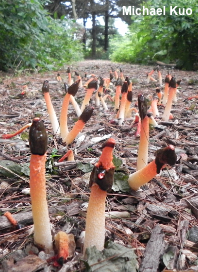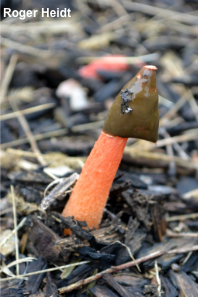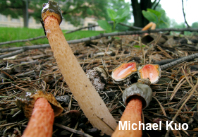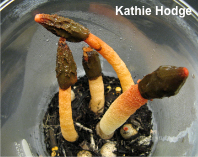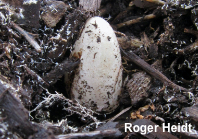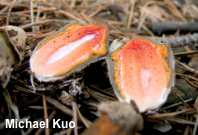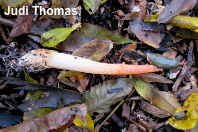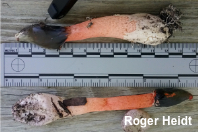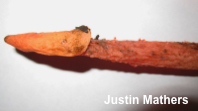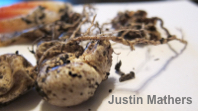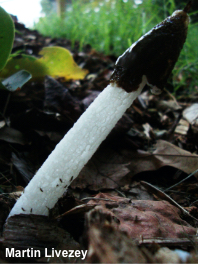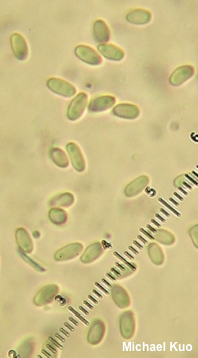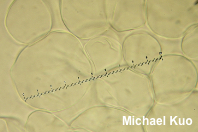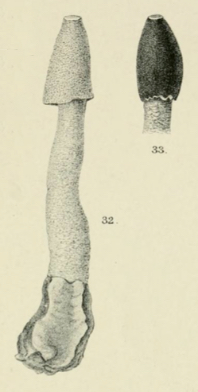| Major Groups > Stinkhorns > Phallus rugulosus |

|
Phallus rugulosus [ Basidiomycota > Agaricomycetes > Phallales > Phallaceae > Phallus . . . ] by Michael Kuo Phallus rugulosus is a widespread and frequently mis-labeled stinkhorn found in Asia and the Americas. Like all stinkhorns it produces its spores in a malodorous goo that attracts insects, who then disperse the spores elsewhere. In some ways Phallus rugulosus is similar to Mutinus elegans and other Mutinus species, since it is skinny and reddish orange, with a brown tip. But close examination reveals a crucial difference: Phallus rugulosus has a clearly separated head structure holding the spore slime, while Mutinus species produce the slime on the stem itself. Rarely, Phallus rugulosus appears in a white-stemmed form (see illustration) that is otherwise identical to the usual, orange form. In fact the white-stemmed form can be found growing alongside its "normal" brethren. Interestingly, the white version turns yellowish when dried and is indistinguishable in the herbarium. Phallus rugulosus has been labeled "Phallus rubicundus" in many treatments (including this website and several of my books), but it turns out that there are two very similar species that can be separated on the basis of their colors and stature, as long as you are looking at fresh collections (as opposed to dried specimens from herbaria). Phallus rubicundus has a red to pink stem that is, on average, somewhat thicker than the skinny, orange-when-fresh stem of Phallus rugulosus. In North America the two species also have different ranges; Phallus rubicundus generally stays south of a line between roughly Oklahoma and Virginia, while Phallus rugulosus is more common from roughly the same line northward, although there is some overlap. In Africa, Phallus aurantiacus is also similar, but features a thicker, yellow-orange stem and a thicker, more cylindric head. Brazilian treatments of Phallus rubicundus (e.g. Cortez and Silva-Filho 2017, Medeiros et al. 2017, Trierveiler-Pereira et al. 2009) appear to represent Phallus rugulosus, as does the treatment of Phallus rubicundus in Hawaii by Hemmes and Desjardin (2002). Calonge (2005) treats Phallus rugulosus as a synonym of Phallus rubicundus. Thanks to Roger Heidt, Kathie Hodge, Martin Livezey, Justin Mathers, and Judi Thomas for documenting, collecting, and preserving Phallus rugulosus for study; their collections are deposited in The Herbarium of Michael Kuo. Description: Ecology: Saprobic; growing alone or gregariously in urban locations, including gardens, landscaping mulch, woodchip beds, lawns, and cultivated areas; spring through fall in temperate climates, but potentially year round in tropical and subtropical areas; fairly common in North America from the Midwest to the Mid-Atlantic states; also recorded from South America, Hawaii and Asia (originally described from Japan). The described and illustrated collections are from Illinois, Iowa, Maryland, Michigan, Missouri, and New York. Immature Fruiting Body: Like a whitish to slightly purplish "egg" 2–3.5 cm high and 1.5–2 cm wide; egg-shaped or nearly round; base attached to thin whitish rhizomorphs; when sliced revealing the orangish stinkhorn-to-be encased in a brownish gelatinous substance. Mature Fruiting Body: Cylindric, with a clearly differentiated head structure that is separate from the stem but may collapse against the stem surface with age. Head: 1.5–2.5 cm high; attached to the top of the stem; conic or nearly so; often becoming perforated at the apex; smooth or granular and wrinkled; red when fresh, fading to orange; initially covered by dark brown spore slime; sometimes with a few patches of universal veil. Stem: 8–12 cm high; 1–1.5 cm thick; cylindric or slightly tapered to apex; dry; very rarely white throughout development, but usually reddish orange when fresh, fading from the base up to pale pinkish orange; pocketed; hollow; base enclosed in a white to purplish or brownish volva 1–2 cm high and 2–3 cm wide; attached to white rhizomorphs. Microscopic Features: Spores 4–5 x 1.5–2 µm; elongated-ellipsoid to cylindric; smooth; hyaline in KOH. Sphaerocysts of the pseudostipe 19–56 µm; irregularly subglobose; smooth; walls 1–1.5 µm thick; hyaline in KOH. Hyphae of the volva 2.5–7.5 µm wide; smooth; hyaline in KOH; conspicuously clamped at septa. REFERENCES: (E. Fischer, 1886) Lloyd, 1908. (Note: some of the following sources treat P. rugulosus as P. rubicundus. Kreisel, 1996; Hemmes & Desjardin, 2009; Hosaka, 2010; Kuo & Methven, 2010; Hosaka, 2012; Kuo & Methven, 2014; Baroni, 2017; Cortez & Silva-Filho, 2017; Woehrel & Light, 2017; Sturgeon, 2018.) Herb. Kuo 09110701, 06131101, 08301201, 07141301, 07151403, 10151401, 07081501, 05271601, 08201701, 08211701, 08231701, 09191803. This site contains no information about the edibility or toxicity of mushrooms. |
© MushroomExpert.Com |
|
Cite this page as: Kuo, M. (2019, December). Phallus rugulosus. Retrieved from the MushroomExpert.Com Web site: http://www.mushroomexpert.com/phallus_rugulosus.html |
